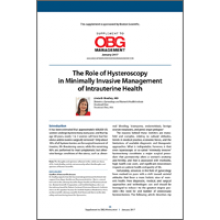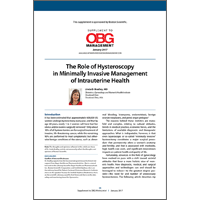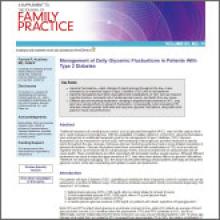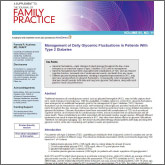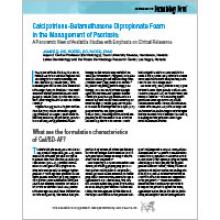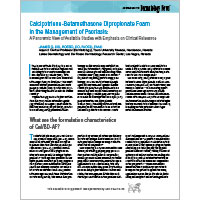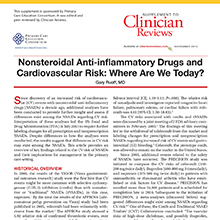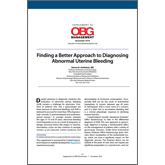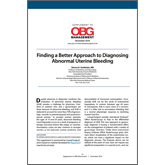User login
Role of the Kidney in Type 2 Diabetes and Mechanism of Action of Sodium Glucose Cotransporter-2 Inhibitors
While type 2 diabetes (T2D) is commonly seen in primary care, it is difficult to manage successfully over time. This series offers brief eNewsletters written by clinical experts that are designed to assist in the clinical management of patients with T2D.
While type 2 diabetes (T2D) is commonly seen in primary care, it is difficult to manage successfully over time. This series offers brief eNewsletters written by clinical experts that are designed to assist in the clinical management of patients with T2D.
While type 2 diabetes (T2D) is commonly seen in primary care, it is difficult to manage successfully over time. This series offers brief eNewsletters written by clinical experts that are designed to assist in the clinical management of patients with T2D.
The Role of Hysteroscopy in Minimally Invasive Management of Intrauterine Health
Faculty/Faculty Disclosure
Linda D. Bradley, MD
Obstetrics, Gynecology and Women’s
Health Institute,
Cleveland Clinic,
Cleveland, Ohio, USA
Competing Interest and Financial Disclosures: Dr. Bradley reports that she has received grant/research/clinical trial support from Bayer Healthcare Pharmaceuticals Inc. She is a consultant and on the advisory board for Bayer Healthcare Pharmaceuticals Inc., Boston Scientific Corporation, and Smith & Nephew; she is on the advisory board for Patient-Centered Outcomes Research Institute; she is on the speakers' bureau for Smith & Nephew (Medtronic); she is on the scientific advisory panel for Karl Storz; and she is on the data safety and monitoring board for Gynesonics.
Faculty/Faculty Disclosure
Linda D. Bradley, MD
Obstetrics, Gynecology and Women’s
Health Institute,
Cleveland Clinic,
Cleveland, Ohio, USA
Competing Interest and Financial Disclosures: Dr. Bradley reports that she has received grant/research/clinical trial support from Bayer Healthcare Pharmaceuticals Inc. She is a consultant and on the advisory board for Bayer Healthcare Pharmaceuticals Inc., Boston Scientific Corporation, and Smith & Nephew; she is on the advisory board for Patient-Centered Outcomes Research Institute; she is on the speakers' bureau for Smith & Nephew (Medtronic); she is on the scientific advisory panel for Karl Storz; and she is on the data safety and monitoring board for Gynesonics.
Faculty/Faculty Disclosure
Linda D. Bradley, MD
Obstetrics, Gynecology and Women’s
Health Institute,
Cleveland Clinic,
Cleveland, Ohio, USA
Competing Interest and Financial Disclosures: Dr. Bradley reports that she has received grant/research/clinical trial support from Bayer Healthcare Pharmaceuticals Inc. She is a consultant and on the advisory board for Bayer Healthcare Pharmaceuticals Inc., Boston Scientific Corporation, and Smith & Nephew; she is on the advisory board for Patient-Centered Outcomes Research Institute; she is on the speakers' bureau for Smith & Nephew (Medtronic); she is on the scientific advisory panel for Karl Storz; and she is on the data safety and monitoring board for Gynesonics.
Management of Daily Glycemic Fluctuations in Patients With Type 2 Diabetes
While type 2 diabetes is commonly seen in primary care, it is difficult to manage successfully over time. This series offers brief eNewsletters written by clinical experts that are designed to assist in the clinical management of patients with type 2 diabetes.
While type 2 diabetes is commonly seen in primary care, it is difficult to manage successfully over time. This series offers brief eNewsletters written by clinical experts that are designed to assist in the clinical management of patients with type 2 diabetes.
While type 2 diabetes is commonly seen in primary care, it is difficult to manage successfully over time. This series offers brief eNewsletters written by clinical experts that are designed to assist in the clinical management of patients with type 2 diabetes.
Calcipotriene-Betamethasone Dipropionate Foam in the Management of Psioriasis: A Panoramic View of Available Studies with Emphasis on Clinical Relevance
In this supplement you will learn about:
- The formulation characteristics of calcipotriene-betamethasone dipropionate aerosol foam (Cal/BD-AF)
- The efficacy and safety of Cal/BD-AF
- The results of Phase III clinical trials completed with Cal/BD-AF
James Q. Del Rosso, DO, FAOCD, FAAD
Adjunct Clinical Professor (Dermatology), Touro University Nevada, Henderson, Nevada
Lakes Dermatology and Del Rosso Dermatology Research Center, Las Vegas, Nevada
Dr. Del Rosso discloses that he is a consultant, speaker, and researcher for LEO Pharma Inc. Related to this subject area he is also a consultant, speaker, and/or researcher for Aqua Pharmaceuticals/Almirall, S.A.; Bayer AG; Celgene Corporation; Galderma Laboratories, L.P.; Genentech, Inc.; Novan, Inc.; Novartis Pharmaceuticals Corporation; Pfizer Inc. /Anacor Pharmaceuticals, Inc.; PharmaDerm; Promius Pharma, LLC; Sun Pharmaceutical Industries, Ltd.; and Valeant Pharmaceuticals International, Inc.
In this supplement you will learn about:
- The formulation characteristics of calcipotriene-betamethasone dipropionate aerosol foam (Cal/BD-AF)
- The efficacy and safety of Cal/BD-AF
- The results of Phase III clinical trials completed with Cal/BD-AF
James Q. Del Rosso, DO, FAOCD, FAAD
Adjunct Clinical Professor (Dermatology), Touro University Nevada, Henderson, Nevada
Lakes Dermatology and Del Rosso Dermatology Research Center, Las Vegas, Nevada
Dr. Del Rosso discloses that he is a consultant, speaker, and researcher for LEO Pharma Inc. Related to this subject area he is also a consultant, speaker, and/or researcher for Aqua Pharmaceuticals/Almirall, S.A.; Bayer AG; Celgene Corporation; Galderma Laboratories, L.P.; Genentech, Inc.; Novan, Inc.; Novartis Pharmaceuticals Corporation; Pfizer Inc. /Anacor Pharmaceuticals, Inc.; PharmaDerm; Promius Pharma, LLC; Sun Pharmaceutical Industries, Ltd.; and Valeant Pharmaceuticals International, Inc.
In this supplement you will learn about:
- The formulation characteristics of calcipotriene-betamethasone dipropionate aerosol foam (Cal/BD-AF)
- The efficacy and safety of Cal/BD-AF
- The results of Phase III clinical trials completed with Cal/BD-AF
James Q. Del Rosso, DO, FAOCD, FAAD
Adjunct Clinical Professor (Dermatology), Touro University Nevada, Henderson, Nevada
Lakes Dermatology and Del Rosso Dermatology Research Center, Las Vegas, Nevada
Dr. Del Rosso discloses that he is a consultant, speaker, and researcher for LEO Pharma Inc. Related to this subject area he is also a consultant, speaker, and/or researcher for Aqua Pharmaceuticals/Almirall, S.A.; Bayer AG; Celgene Corporation; Galderma Laboratories, L.P.; Genentech, Inc.; Novan, Inc.; Novartis Pharmaceuticals Corporation; Pfizer Inc. /Anacor Pharmaceuticals, Inc.; PharmaDerm; Promius Pharma, LLC; Sun Pharmaceutical Industries, Ltd.; and Valeant Pharmaceuticals International, Inc.
Nonsteroidal Anti-inflammatory Drugs and Cardiovascular Risk: Where Are We Today?
- Historical Overview
- Mechanistic Basis for a Cardiovascular Hazard
- Evidence from Meta-Analyses
- Cardiovascular Risk
- Implications for Patient Management
Faculty/Faculty Disclosure:
Gary Rouff, MD
Clinical Professor of Family Medicine,
Department of Family Practice,
Michigan State University
College of Medicine, Director of Clinical
Research, Westside Family Medical Center
Kalamazoo, MI
Dr. Rouff discloses that he has no real or apparent conflict of interest to report
- Historical Overview
- Mechanistic Basis for a Cardiovascular Hazard
- Evidence from Meta-Analyses
- Cardiovascular Risk
- Implications for Patient Management
Faculty/Faculty Disclosure:
Gary Rouff, MD
Clinical Professor of Family Medicine,
Department of Family Practice,
Michigan State University
College of Medicine, Director of Clinical
Research, Westside Family Medical Center
Kalamazoo, MI
Dr. Rouff discloses that he has no real or apparent conflict of interest to report
- Historical Overview
- Mechanistic Basis for a Cardiovascular Hazard
- Evidence from Meta-Analyses
- Cardiovascular Risk
- Implications for Patient Management
Faculty/Faculty Disclosure:
Gary Rouff, MD
Clinical Professor of Family Medicine,
Department of Family Practice,
Michigan State University
College of Medicine, Director of Clinical
Research, Westside Family Medical Center
Kalamazoo, MI
Dr. Rouff discloses that he has no real or apparent conflict of interest to report
Finding a Better Approach to Diagnosing Abnormal Uterine Bleeding
Click here to download the PDF.
Despite advances in diagnostic medicine, the evaluation of abnormal uterine bleeding (AUB) remains a challenge for physicians. In this supplement, learn about:
- Pathophysiology and differential diagnosis of AUB
- The limitations of blind endometrial biopsy
- The differences between diagnostic hysteroscopy options
Author
Steven R. Goldstein, MD
Professor of Obstetrics and Gynecology
New York University School of Medicine
Immediate Past President
American Institute of Ultrasound in Medicine
Director of Gynecologic Ultrasound and Co-Director of Bone Densitometry
New York University Medical Center
New York, New York
DISCLOSURES
Dr. Goldstein discloses that he is a paid consultant for CooperSurgical.
Click here to download the PDF.
Despite advances in diagnostic medicine, the evaluation of abnormal uterine bleeding (AUB) remains a challenge for physicians. In this supplement, learn about:
- Pathophysiology and differential diagnosis of AUB
- The limitations of blind endometrial biopsy
- The differences between diagnostic hysteroscopy options
Author
Steven R. Goldstein, MD
Professor of Obstetrics and Gynecology
New York University School of Medicine
Immediate Past President
American Institute of Ultrasound in Medicine
Director of Gynecologic Ultrasound and Co-Director of Bone Densitometry
New York University Medical Center
New York, New York
DISCLOSURES
Dr. Goldstein discloses that he is a paid consultant for CooperSurgical.
Click here to download the PDF.
Despite advances in diagnostic medicine, the evaluation of abnormal uterine bleeding (AUB) remains a challenge for physicians. In this supplement, learn about:
- Pathophysiology and differential diagnosis of AUB
- The limitations of blind endometrial biopsy
- The differences between diagnostic hysteroscopy options
Author
Steven R. Goldstein, MD
Professor of Obstetrics and Gynecology
New York University School of Medicine
Immediate Past President
American Institute of Ultrasound in Medicine
Director of Gynecologic Ultrasound and Co-Director of Bone Densitometry
New York University Medical Center
New York, New York
DISCLOSURES
Dr. Goldstein discloses that he is a paid consultant for CooperSurgical.
Fostering surgical innovation: The path forward
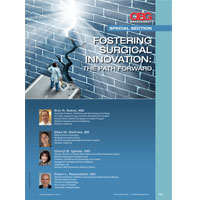
Click here to download the PDF.
Key learning objectives
The faculty for this roundtable aim to:
- Explain the process for bringing an innovation to market, including the roles of surgeon inventor, engineer, manufacturer, and industry
- Discuss best practices, based on lessons learned, when pursuing an innovative idea for patient care
- Articulate ways to improve upon the entire development process for new techniques, devices, etc, being brought to the FDA for possible approval and to market for patient use.

Click here to download the PDF.
Key learning objectives
The faculty for this roundtable aim to:
- Explain the process for bringing an innovation to market, including the roles of surgeon inventor, engineer, manufacturer, and industry
- Discuss best practices, based on lessons learned, when pursuing an innovative idea for patient care
- Articulate ways to improve upon the entire development process for new techniques, devices, etc, being brought to the FDA for possible approval and to market for patient use.

Click here to download the PDF.
Key learning objectives
The faculty for this roundtable aim to:
- Explain the process for bringing an innovation to market, including the roles of surgeon inventor, engineer, manufacturer, and industry
- Discuss best practices, based on lessons learned, when pursuing an innovative idea for patient care
- Articulate ways to improve upon the entire development process for new techniques, devices, etc, being brought to the FDA for possible approval and to market for patient use.


